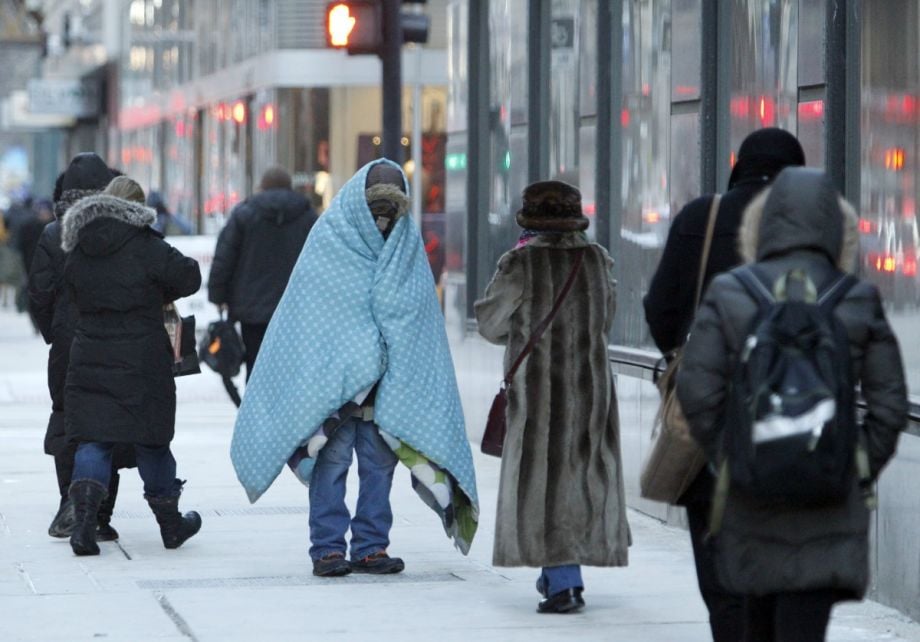Winter arrived in the U.S. this week. Chicago, which endured record-breaking low temperatures last year, is once again down to 15 degrees (below zero if you count the wind chill). On Monday, city officials held a press conference detailing their preparations for winter. Among them were plans for dumping 400,000 tons of salt on roads and exhortations to drivers to avoid blocking snow plows. “Whatever Mother Nature decides to throw at the city of Chicago, the city of Chicago is ready,” Mayor Rahm Emanuel announced.
Strangely, however, the event lacked any mention of people suffering through extreme cold — despite data showing the local homeless population has risen 19.4 percent in the past year alone. That survey by the Chicago Coalition for the Homeless concluded that 138,575 Chicagoans experienced homelessness in the 2013-2014 school year — with many on the streets during early 2014’s life-threatening polar vortexes.
In 2013, a survey of 23 American cities by the U.S. Conference of Mayors found that, on average, each city had 32,466 people on the streets each night. “People die in the streets every winter,” says Steve Berg, of the National Alliance to End Homelessness. When the temperature plunges below zero, how do people without homes last the night?
Emergency shelters don’t offer a full solution. The city of Chicago lists 113 “warming centers,” but most are only open from 9 a.m. to 5 p.m. The number of emergency shelter beds is far outstripped by demand, too.
“There are about 22,000 homeless students in the Chicago Public School system every year,” says Stacy Massey. “Are there 22,000 beds? No.” Massey works for the Night Ministry, a non-profit that operates multiple emergency and transitional shelters in Chicago for people under the age of 25. “We would give people bus cards so they could get somewhere or ride the train all night” once the shelter was at capacity, she says. Massey is identifying a common survival method in Chicago: sleeping on trains that run 24/7. It’s one of the reasons homeless organizations purchase thousands of train tickets each year.
But the practice is poorly received by the general public, and the homeless themselves dislike it. Nomi Michaels Devereaux, a 33-year-old Chicagoan, experienced homelessness in her teenage years. (In 2011, I briefly worked for the Night Ministry; Devereaux was a colleague.) She says, “Oh my god, the subway, it was scary. You get on the train, they harass you.” She says Chicago Transit Authority workers or police sometimes forcibly remove all-night riders, stranding them outside and far from help. She called sleeping on the train a last resort.
Like many homeless people, she was also reluctant to use shelters. As a transgender woman, Devereaux says, “I didn’t fit the criteria of the shelters.” As an alternative, “I built up a pretty dynamic system for sleeping on the streets.” Her secret? An improvised bivouac shelter of a blanket and plastic tarp. “Plastic is essential,” Devereaux says. “It was so warm that in the morning I was scared to go outside. I’d uncover the blanket and be like, ‘Oh my god, it is cold.’”
In the years since Devereaux was homeless, Chicago has aimed at eliminating the need for city-dwellers to rely on such survivalist techniques. In 2003, the city government launched the “10 Year Plan to End Homelessness,” then heralded by the NAEH as cutting edge. At the end of its lifespan, however, the city was no closer to that goal — and has since slipped back even farther.
The city has unveiled “Plan 2.0,” which aims at the same goal. But the plan curiously frames the reduction of emergency shelter beds from 5,811 in 2002 to 1,329 in 2012 as a “best practice” — and if the Mayor’s press conference this week is any indication, the priority on helping people will remain low.
Chicago Alderman Bob Fioretti agrees. “We had a better program under [preceding] Mayor Daley. If I had homeless individuals that were out in the street, I would be able to make one call to a department of human resources that would come out there and help that population. That doesn’t happen under this administration.” Fioretti, who is opposing Emanuel in Chicago’s upcoming mayoral election, says he’ll make the goal a reality by “finding ways to put people to work rehabbing vacant homes,” for homeless people to occupy.
Few homeless organizations anticipate a substantial shift in policy — or the number of homeless — after Election Day, however. “Just because there’s an election doesn’t mean there’s going to be a changing of the guard,” Catholic Charities representative Kristine Kappel points out. NAEH’s Berg adds that administration changes are no guarantee of substantial policy shifts.
Whatever happens in halls of power, neither citizens nor non-profits are ignoring the country’s extreme weather. Since the Night Ministry opened its newest shelter in early 2011, Massey says, “four or five more emergency shelters popped up,” and Catholic Charities added a shuttle to drive individuals to facilities with the capacity to accept them. Kappel adds that individual donations increase as winter begins.
People nationwide will need the help. Per the NAEH, some 610,042 people are homeless in America at any given time – including some in upstate New York, which experienced a deadly snowstorm this week. Meteorologists are predicting the Arctic blasts are just beginning.

M. Sophia Newman is a freelance writer and an editor with a substantial background in global health and health research. She wrote Next City's Health Horizons column from 2015 to 2016 and has reported from Bangladesh, India, Nepal, Kenya, Ghana, South Africa, and the United States on a wide range of topics. See more at msophianewman.com.
Follow M. Sophia .(JavaScript must be enabled to view this email address)















